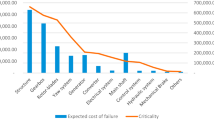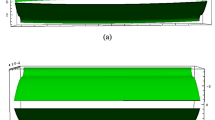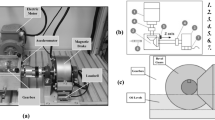Abstract
Mechanical gears are used to transmit power and motion in mechanical, electrical and chemical process industries. Influenced by vibration, torque, temperature, lubrication and specific film thickness, the gear teeth contacts may experience change leading to unexpected failures such as wear, scuffing, pitting and micro-pitting on teeth surface. In order to avoid these damages, continuous monitoring is essential using knowledge-based systems. Generic capability of artificial neural network is exploited to formulate prediction and classification based on heuristic models of condition of lubricating oil in spur gears. Based on the loading conditions such as vibration, temperature and torque, the algorithm predicts film thickness to classify oil conditions as elasto-hydrodynamic, mixed wear and severe wear that helps in finding faults during operation of gears.












Similar content being viewed by others
Explore related subjects
Discover the latest articles, news and stories from top researchers in related subjects.References
Radovich JL (1984) Gears, handbook of lubrication (theory and practice of tribology), Vol. II. In: Booser ER (ed) CRC Press. FL, Boca Raton, pp 539–564
Dudley DW (1980) Gear wear. In: Peterson MB, Winer WO (eds) Wear control handbook. The American Society of Mechanical Engineers, New York, pp 755–830
Kubo A, Townsend DP (1991) Gear lubrication, in Dudley’s Gear Handbook, In: Townsend DP (Ed), McGraw-Hill, New York, 15.1–31
Samanta B, Al- Baulshi KR, Al-Araimi SA (2003) Artificial neural network based Fault diagnostics of rolling element bearings using time domain features. Mech Syst Signal Process 17(2):317–328
Samantha B (2004) Gear fault using artificial neural networks and support vector machines with genetic algorithms. Mech Syst Signal Process 18:625–644
Davis A (1997) Handbook of condition monitoring. London: Chapman & Hall; 1988 In: Drosjack MJ, Houser DR (eds) An experimental and theoretical study of the effect of simulated pitch line pitting on the vibration of a geared system, ASME publication report 7-DET-123
Sung CK, Tai HM, Chen HM (2000) Locating defects of gear system by the technique of wavelet transform, Mech Mach Theory
Amarnath M, Sujatha C, Swarnamani S (2009) Experimental studies on the effects of reduction in gear tooth stiffness and lubricant film thickness in a spur geared system. Tribol Int 42:340–352
Dowson D, Higginson GR (1977) Elastohydrodynamic lubrication. Pergamon Press Ltd, New York
Bartz JW (1993) Lubrication of gearing. Mechanical Engineering publication Ltd, London
Höhn B-R, Michaelis K (2003) Influence of oil temperature on gear failures. Tribol Int 37:103–109
Haykin S (1994) Neural networks: a comprehensive foundation. Macmillan College Publishing, New York
Booth C, McDonald JR (1998) The use of artificial neural networks for condition monitoring of electrical power transformers, Elsevier Science B.V. Neurocomputing 23:97–109
Peng Z, Kessissoglou N (2002) An integrated approach to fault diagnosis of machinery wear debris and vibration analysis. Wear 225(7–12):1221–1232
Dempsey PJ (2002) Wear damage detection using oil debris analysis. NASA TM 211492, ARL-TR-2682
Hamrock BJ, Dawson D (1977) Isothermal elastohydrodynamic lubrication of point contacts, Part III—fully flooded results. ASME J Lubr Tech 99(2):264–276
Author information
Authors and Affiliations
Corresponding author
Rights and permissions
About this article
Cite this article
Sreepradha, C., Krishna Kumari, A., Elaya Perumal, A. et al. Neural network model for condition monitoring of wear and film thickness in a gearbox. Neural Comput & Applic 24, 1943–1952 (2014). https://doi.org/10.1007/s00521-013-1427-6
Received:
Accepted:
Published:
Issue Date:
DOI: https://doi.org/10.1007/s00521-013-1427-6




